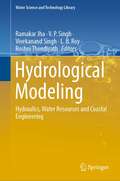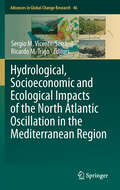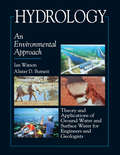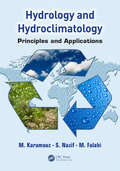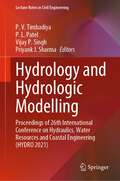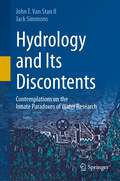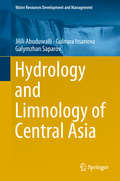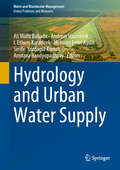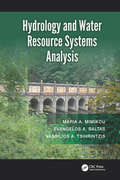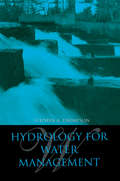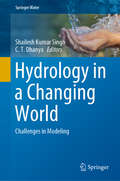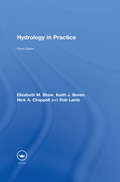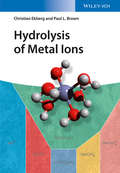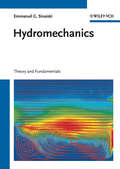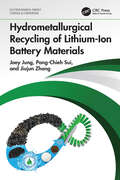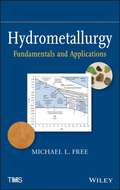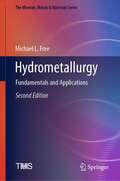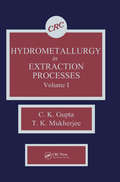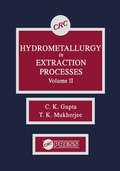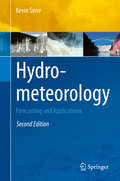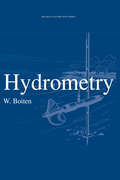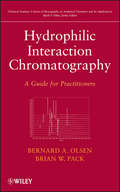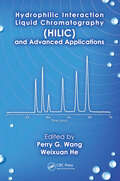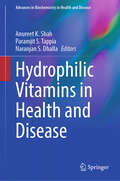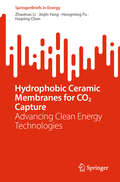- Table View
- List View
Hydrological Modeling: Hydraulics, Water Resources and Coastal Engineering (Water Science and Technology Library #109)
by V. P. Singh Ramakar Jha Vivekanand Singh L. B. Roy Roshni ThendiyathThis book carefully considers hydrological models which are essential for predicting floods, droughts, soil moisture estimation, land use change detection, geomorphology and water structures. The book highlights recent advances in the area of hydrological modelling in the Ganga Basin and other internationally important river basins. The impact of climate change on water resources is a global concern. Water resources in many countries are already stressed, and climate change along with burgeoning population, rising standard of living and increasing demand are adding to the stress. Furthermore, river basins are becoming less resilient to climatic vagaries. Fundamental to addressing these issues is hydrological modelling which is covered in this book. Integrated water resources management is vital to ensure water and food security. Integral to the management is groundwater and solute transport, and this book encompasses tools that will be useful to mitigate the adverse consequences of natural disasters.
Hydrological, Socioeconomic and Ecological Impacts of the North Atlantic Oscillation in the Mediterranean Region
by Sergio M. Vicente-Serrano Ricardo M. TrigoThe Mediterranean basin represents one of the most important "hot spots" of climate change in the world, with recent trends towards a hotter and drier climate being related to changes in atmospheric circulation patterns. Such changes can have significant impacts in the climate of this region but also on the natural environment and several socioeconomic activities. Among these patterns, the North Atlantic Oscillation (NAO) is one of the main forcing factors in the region with impact on extreme events such as droughts, severe precipitations or heat and cold waves, the availability of water resources, the ecological dynamics, the quality and quantity of crops, the migration and welfare of animal populations, the fisheries dynamics, the triggering of landslides and the air pollution and human health, among others. The aim of Hydrological, Socioeconomic and Ecological Impacts of the North Atlantic Oscillation in the Mediterranean Region, is to serve as an updated reference text that covers the wide range of evidences on the NAO impacts in the Mediterranean regions and from a multidisciplinary perspective. This volume constitutes a unique document to present the state of the art of the numerous studies undertaken on the hydrological, socioeconomic and ecological impact of the NAO, collecting the expertise of researchers from several complementary earth science fields (geography, hydrology, remote-sensing, climatology, agriculture, energy), but that have been lacking a common ground.
Hydrology: An Environmental Approach
by Ian WatsonHydrology covers the fundamentals of hydrology and hydrogeology, taking an environmental slant dictated by the emphasis in recent times for the remediation of contaminated aquifers and surface-water bodies as well as a demand for new designs that impose the least negative impact on the natural environment. Major topics covered include hydrological principles, groundwater flow, groundwater contamination and clean-up, groundwater applications to civil engineering, well hydraulics, and surface water. Additional topics addressed include flood analysis, flood control, and both ground-water and surface-water applications to civil engineering design.
Hydrology and Hydroclimatology: Principles and Applications
by M. Karamouz S. Nazif M. FalahiThis book presents a systematic approach to understanding and applying the principles of hydrology and hydroclimatology, examining the interactions among different components of the water cycle. It takes a fresh look at the fundamentals and challenges in hydrologic and hydroclimatic systems as well as climate change. The author describes the applic
Hydrology and Hydrologic Modelling: Proceedings of 26th International Conference on Hydraulics, Water Resources and Coastal Engineering (HYDRO 2021) (Lecture Notes in Civil Engineering #312)
by P. V. Timbadiya P. L. Patel Vijay P. Singh Priyank J. SharmaThis book comprises the proceedings of the 26th International Conference on Hydraulics, Water Resources and Coastal Engineering (HYDRO 2021) focusing on broad spectrum of emerging opportunities and challenges in the field of hydrology and hydrological modelling. It covers a range of topics, including, but not limited to, ground water modelling and management, integrated water resources and watershed management, surface water hydrology, drought assessment and mitigation, risk, reliability and design of hydrologic system, etc. Presenting recent advances in the form of illustrations, tables, and text, it offers readers insights for their own research. In addition, the book addresses fundamental concepts and studies in the field of hydrology and hydrological modelling, making it a valuable resource for both beginners and researchers wanting to further their understanding of hydraulics, water resources and coastal engineering.
Hydrology and Its Discontents: Contemplations on the Innate Paradoxes of Water Research
by John T. Van Stan II Jack SimmonsThis book examines the intricate web linking water science and society using diverse philosophical lenses. Highlighting the tensions within the threads of this web, we spotlight major conceptual tightropes that water researchers tread daily. To effectively navigate these delicate threads, a 'healthy' tension in the encompassing web is necessary. Drawing inspiration from Freud's examination of tensions in "Society and Its Discontents," we illuminate the tension-filled paradoxes inherent to water science, emphasizing the challenges in keeping these paradoxical threads taut enough to ensure a navigable and sustainable bond with society. Central to our narrative is the escalating societal urge to quantify and 'manage' water—something interwoven throughout every environmental layer, including the fabric of our being. An excessive focus on management may alienate users from their water realities, jeopardizing the vital threads that sustainability tether water science and society. Consequently, this book explores compelling and inescapable tensions that resist tidy universal resolution, such as: the language of water science, including its mathematical reductions (i.e., models); the effect of water's commodification on its science; hydrology’s intersection with colonialism; and other concerns that reveal distortions in our hydrology. We aim to aid water professionals in recognizing and fine-tuning the paradoxes intrinsic to their work. To underscore the interwoven complexity of contemporary hydrology, "Hydrology and Its Discontents" guides readers into the tempestuous depths of water research, all the while urging a recalibration of perspectives and motivations.
Hydrology and Limnology of Central Asia (Water Resources Development and Management)
by Jilili Abuduwaili Gulnura Issanova Galymzhan SaparovThis book highlights the development of lake systems and water reservoirs as well as the impact of climate change on water resources in Central Asian countries. It provides information on the genesis of lake basins, physical and chemical properties of water in lakes, and the hydrological regimes (water balance and fluctuation levels) of lakes of Central Asia and Xinjiang. The book is useful for scientists and researchers whose work focuses on lakes and the use of natural resources, irrigation, hydropower and water supply, as well as for students and planners.
Hydrology and Urban Water Supply (Water and Wastewater Management)
by Ali Müfit Bahadir Andreas Haarstrick I. Ethem Karadirek Mehmet Emin Aydin Serife Yurdagül Kumcu Amitava BandyopadhyayThis book explores the intricate relationship between hydrology and urban water provision. Authored by experts in the field, this book offers a comprehensive exploration of the challenges and solutions associated with urban water supply management in the context of hydrology. It covers topics such as water sources, treatment technologies, distribution systems, and sustainable water management practices. With its meticulous analysis and practical insights, this book equips professionals, researchers, and policymakers with the knowledge necessary to address the growing demands of urban water supply in an era of climate change and urbanization.
Hydrology and Water Resource Systems Analysis
by Maria A. Mimikou Evangelos A. Baltas Vassilios A. TsihrintzisHydrology and water resources analysis can be looked at together, but this is the only book which presents the relevant material and which bridges the gap between scientific processes and applications in one text. New methods and programs for solving hydrological problems are outlined in a concise and readily accessible form. Hydrology and Water Resource Systems Analysis includes a number of illustrations and tables, with fully solved example problems integrated within the text. It describes a systematic treatment of various surface water estimation techniques; and provides detailed treatment of theory and applications of groundwater flow for both steady-state and unsteady-state conditions; time series analysis and hydrological simulation; floodplain management; reservoir and stream flow routing; sedimentation and erosion hydraulics; urban hydrology; the hydrological design of basic hydraulic structures; storage spillways and energy dissipation for flood control, optimization techniques for water management projects; and methods for uncertainty analysis. It is written for advanced undergraduate and graduate students and for practitioners. Hydrologists and water-related professionals will be helped with an unfamiliar term or a new subject area, or be given a formula, the procedure for solving a problem, or guidance on the computer packages which are available, or shown how to obtain values from a table of data. For them it is a compendium of hydrological practice rather than science, but sufficient scientific background is provided to enable them to understand the hydrological processes in a given problem, and to appreciate the limitations of the methods presented for solving it.
Hydrology for Water Management
by Stephen A. ThompsonContaining over one hundred and sixty line drawings, maps and one hundred tables, this book explains the fundamental hydrologic principles and favoured methods of analysis. Aimed at students interested in natural resources and environmental science, spreadsheet exercises and worked examples help to develop basic problem solving skills.
Hydrology in a Changing World: Challenges in Modeling (Springer Water)
by Shailesh Kumar Singh C. T. DhanyaThis book offers a comprehensive overview of the challenges in hydrological modeling. Hydrology, on both a local and global scale, has undergone dramatic changes, largely due to variations in climate, population growth and the associated land-use and land-cover changes. Written by experts in the field, the book provides decision-makers with a better understanding of the science, impacts, and consequences of these climate and land-use changes on hydrology. Further, offering insights into how the changing behavior of hydrological processes, related uncertainties and their evolution affect the modeling process, it is of interest for all researchers and practitioners using hydrological modeling.
Hydrology in Practice
by Elizabeth M. Shaw Keith J. Beven Nick A. Chappell Rob LambHydrology in Practice is an excellent and very successful introductory text for engineering hydrology students who go on to be practitioners in consultancies, the Environment Agency, and elsewhere. This fourth edition of Hydrology in Practice, while retaining all that is excellent about its predecessor, by Elizabeth M. Shaw, replaces the material on the Flood Studies Report with an equivalent section on the methods of the Flood Estimation Handbook and its revisions. Other completely revised sections on instrumentation and modelling reflect the many changes that have occurred over recent years. The updated text has taken advantage of the extensive practical experience of the staff of JBA Consulting who use the methods described on a day-to-day basis. Topical case studies further enhance the text and the way in which students at undergraduate and MSc level can relate to it. The fourth edition will also have a wider appeal outside the UK by including new material on hydrological processes, which also relate to courses in geography and environmental science departments. In this respect the book draws on the expertise of Keith J. Beven and Nick A. Chappell, who have extensive experience of field hydrological studies in a variety of different environments, and have taught undergraduate hydrology courses for many years. Second- and final-year undergraduate (and MSc) students of hydrology in engineering, environmental science, and geography departments across the globe, as well as professionals in environmental protection agencies and consultancies, will find this book invaluable. It is likely to be the course text for every undergraduate/MSc hydrology course in the UK and in many cases overseas too.
Hydrolysis of Metal Ions
by Paul L. Brown Christian EkbergFilling the need for a comprehensive treatment that covers the theory, methods and the different types of metal ion complexes with water (hydrolysis), this handbook and ready reference is authored by a nuclear chemist from academia and an industrial geochemist. The book includes both cation and anion complexes, and approaches the topic of metal ion hydrolysis by first covering the background, before proceeding with an overview of the dissociation of water and then all different metal-water hydrolysis complexes and compounds. A must-have for scientists in academia and industry working on this interdisciplinary topic.
Hydromechanics: Theory and Fundamentals
by Emmanuil G. SinaiskiWritten by an experienced author with a strong background in applications of this field, this monograph provides a comprehensive and detailed account of the theory behind hydromechanics. He includes numerous appendices with mathematical tools, backed by extensive illustrations. The result is a must-have for all those needing to apply the methods in their research, be it in industry or academia.
Hydrometallurgical Recycling of Lithium-Ion Battery Materials (Electrochemical Energy Storage and Conversion)
by Joey Jung Pang-Chieh Sui Jiujun ZhangThe expanding market share of lithium-ion batteries (LIBs), driven by the secondary battery and electric vehicle markets, has consequently led to the accumulation of spent LIBs. This presents a unique business opportunity for recovering and recycling valuable metals from the spent lithium-ion cathode materials. Hydrometallurgical Recycling of Lithium-Ion Battery Materials provides a comprehensive review of the available hydrometallurgical technologies for recycling spent lithium-ion cathode active materials. The aim of this book is to raise awareness of LIB recycling, provide comprehensive knowledge of hydrometallurgical recycling of lithium cathode active materials, and promote an environmentally friendlier hydrometallurgical recycling process. Key Features • Summarizes current recycling processes, challenges, and perspectives • Offers a comprehensive review of current commercialized LIB recycling companies • Showcases an innovative closed-loop hydrometallurgical recycling process to recycle lithium cathode materials • Provides detailed modeling and economic analyses of several hydrometallurgical recycling processes • Features practical cases and data developed by the authors Offering the most up-to-date information on LIB material recycling, this book is aimed at researchers and professionals in materials, chemical, electrical, and mechanical engineering, as well as chemists working on battery technologies.
Hydrometallurgy: Fundamentals and Applications, 1st Edition
by Michael L. FreeAs the first book to compile the fundamentals, applications, reference information and analytical tools on the topic, Hydrometallurgy presents a condensed collection of information that can be used to improve the efficiency and effectiveness with which metals are extracted, recovered, manufactured, and utilized in aqueous media in technically viable and reliable, environmentally responsible, and economically feasible ways. Suitable for students and researchers, this college-level overview addresses Fundamentals of Chemical Metallurgy in Aqueous Media, Speciation and Phase Diagrams, Rate Processes in Aqueous Metal Processing, Aqueous Metal Extraction and Leaching, Fundamentals of Metal Concentration Processes and more.
Hydrometallurgy: Fundamentals and Applications (The Minerals, Metals & Materials Series)
by Michael L. FreeThis revised, new edition retains its class-tested coverage of how metals behave in water while updating and expanding information about metals processing methods. The book further retains its emphasis on predicting and engineering the way metals are extracted from ore sources, separated from unwanted entities, recovered as metals, and purified using water based processing. The transformation of minerals to metals requires hydrometallurgical processing for nearly all of the nonferrous metals we use. This book elucidates the associated fundamentals and processing applications as well as related tools to assess processes and performance. The new edition further includes additional photographs, updated drawings, supplementary data, updated descriptive information, and new detail on rare earth elements processing as well as recycling and byproduct recovery of metals.
Hydrometallurgy in Extraction Processes, Volume I
by T.K. MukherjeeThis two-volume set provides a full account of hydrometallurgy. Filled with illustrations and tables, this work covers the flow of source material from the mined or concentrate state to the finished product. It also highlights ion exchange, carbon adsorption and solvent extraction processes for solution purification and concentration. The extensive
Hydrometallurgy in Extraction Processes, Volume II
by C. K. Gupta T. K. MukherjeeThis two-volume set provides a full account of hydrometallurgy. Filled with illustrations and tables, this work covers the flow of source material from the mined or concentrate state to the finished product. It also highlights ion exchange, carbon adsorption and solvent extraction processes for solution purification and concentration. The extensive reference list-over 850-makes this set a valuable resource for extraction and process metallurgists, researchers, and practitioners.
Hydrometeorology
by Kevin SeneThis book describes recent developments in hydrometeorological forecasting techniques for a range of timescales, from short term to seasonal and longer terms. Following an introduction to measurement and modelling techniques, subsequent chapters discuss a range of practical applications in flood and drought forecasting, climate change and environmental impact assessments, water resources and water quality studies, agriculture, hydropower, river basin management. The book is useful for civil engineering, water resources, meteorology and hydrology courses for post-graduate students, but is primarily intended as a state-of-the-art review for a wider audience. Kevin Sene is a civil engineer and researcher with wide experience in flood forecasting, water resources and hydrometeorological studies. He has published some 45 scientific and conference papers on topics in hydrology, hydrometeorology and hydraulics.
Hydrometry: IHE Delft Lecture Note Series
by W. BoitenHydrometry presents a thorough introduction to the science of hydrometry: the measurement of flow in open channels. Dealing with both traditional techniques and innovative new methods and instruments, in line with the latest ISO standards, this book deals with the main themes of hydrometry: the measurement of water levels and bed levels,
Hydrophilic Interaction Chromatography: A Guide for Practitioners (Chemical Analysis: A Series of Monographs on Analytical Chemistry and Its Applications #177)
by Bernard A. Olsen Brian W. PackDiscover how to use HILIC to analyze and better understand polar compounds An increasingly popular analytical method, hydrophilic interaction chromatography (HILIC) has the ability to retain and separate polar compounds that are often difficult to analyze by reversed-phase high-performance liquid chromatography (HPLC) or other analytical methods. Offering a comprehensive review, this book enables readers to develop a fundamental understanding of how HILIC works and then apply that knowledge to develop and implement a variety of practical applications. Hydrophilic Interaction Chromatography begins with discussions of HILIC retention mechanisms, stationary phases, and general method development. This sets the foundation for the book's extensive coverage of applications. The authors address unique separation challenges for bioanalytical, environmental, pharmaceutical, and biochemical applications. Moreover, there is a thorough discussion of HILIC in two-dimensional chromatography. With contributions from leading analytical scientists who have extensive experience in HILIC as well as HPLC, Hydrophilic Interaction Chromatography serves as a practical guide for researchers, featuring: Detailed examples of HILIC methods and development approaches Thorough explanations of retention mechanisms and the impact of stationary phase and mobile phase properties on separations Step-by-step guidance for developing efficient, sensitive, and robust HILIC methods References to the primary literature at the end of each chapter Hydrophilic Interaction Chromatography is written for scientists who use or develop analytical methods for the separation of polar compounds. In particular, these researchers will discover how HILIC can be used to analyze and better understand the composition of pharmaceutical, bioanalytical, biochemical, chemical, food, and environmental samples.
Hydrophilic Interaction Liquid Chromatography (Chromatographic Science Series)
by Perry G. Wang Weixuan HeThis is the first book that comprehensively and systematically describes the new technology of hydrophilic interaction liquid chromatography (HILIC). Hydrophilic interaction chromatography is a separation technique suitable for polar and hydrophilic compounds and orthogonal to reversed phase liquid chromatography. From small organic molecules to pr
Hydrophilic Vitamins in Health and Disease (Advances in Biochemistry in Health and Disease #29)
by Anureet K. Shah Paramjit S. Tappia Naranjan S. DhallaMore than 100 years ago, Dr Casimir Funk suggested the existence of a family of organic substances that are essential for life and thus introduced the concept of “vital amines” as essential nutrients with a specific action, requiring only minute amount with the power to cure a specific disease. Vitamins essential for human health are grouped according to whether they are soluble in water (hydrophilic) or in non-polar solvents (lipophilic). The hydrophilic vitamins are vitamin C and a series known as the vitamin B complex. Vitamin C is a reducing agent, whereas the vitamin B series are components of coenzymes. For example, riboflavin (vitamin B2) is a precursor of flavin adenine dinucleotide (FAD) and pantothenate (vitamin B5) is a component of coenzyme A. Indeed, several coenzymes contain a vitamin as part of their structure; this relation is undoubtedly responsible for creating an “essential” role for the vitamin. Since vitamins are involved in a wide range of biological processes and cell function, these are considered as essential nutrients. The essential nature of vitamins as well as their unique biochemistry, molecular mechanisms and cellular function in health and disease are emphasized in this book which will serve as a highly useful resource for health professionals, nutritional scientists, medical students, fellows, residents, and graduate students.
Hydrophobic Ceramic Membranes for CO2 Capture: Advancing Clean Energy Technologies (SpringerBriefs in Energy)
by Zhaohao Li Jinjin Yang Hongming Fu Haiping ChenThis book focuses on developing and optimizing ceramic membranes with hydrophobic and superhydrophobic properties for CO2 capture in membrane contactors, aimed at improving CO2 capture technology in thermal power plants and other industries. It examines the preparation of ceramic membranes, the mass transfer mechanisms in porous media, and the specific processes involved in capturing CO2. The book also compares the performance of commercial Al2O3 ceramic membranes with traditional polytetrafluoroethylene membranes and explores ways to enhance the efficiency of CO2 capture by addressing challenges such as membrane wetting and increased mass transfer resistance. Additionally, it introduces a cost-effective superhydrophobic ceramic membrane made from power plant waste fly ash, analyzing its performance and surface dynamics for CO2 capture applications. It is a useful tool for researchers, academics, professionals and graduates interested in the field of chemical engineering, environmental science, and materials science, particularly those focused on CO2 capture technologies, membrane science, and clean energy solutions.
